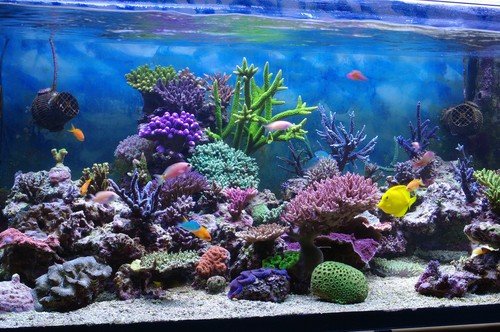Fungal infections are most common in fishes. Mainly injured and diseased fishes easily catch this infection. Poor water quality is another reason which could result in fungal infections. If not treated properly, on time, then it may create problems. These fungal infections are highly contagious. One can easily identify the exterior fungal infections as most of the fungal infections form a fluffy white appearance. It creates a white fungus in a fish tank. If the fungal infection increases, then it may turn into a red or gray color.
These fungal infections mainly affect the external tissues of fish. However, few fungal infections can affect the internal organs of the fish. All the aquariums have fungi, but there are a few reasons which lead to fungal infections. The various reasons are
- Poor quality of water in the aquarium
- Injured fish or diseased fish
- Poor hygiene
- A large amount of organic waste floating in the water
Ways to Remove Fungus in the Fish Tank and Protect Fish from Fungal Infections
If your fish gets sick, it could be due to fungus in the fish tank. The primary fungal infections are Saprolegina and Achyla, which weakens the immune system of fish. These diseases are very dangerous if not treated on time properly. There are three methods by which you can get rid of the fungus in the fish tank. The methods for fish tank fungus treatment are as follows.
Method 1 – Treating your fish
Treatment tank
Buy a small tank in which your fish can move around. Add some water in it and heat it with an aquarium heater at the temperature of 21-25°C. Check and test the water to make sure it is chlorine-free, and the PH balance is accurate. You can monitor the behavior of the fish there, and the rest of the aquarium will not be polluted.
The treatment tank can be small. The treatment tank doesn’t need to be as big as your permanent aquarium. The fish will be kept in the treatment tank only for the treatment, maybe for a few weeks. The fish does not need a large tank during treatment.
Separation of infected fish from uninfected fish
If there is any infected fish in your permanent tank then, you just move the fish gently to the treatment tank. Infected fish can spread fungal infections to healthy fishes. So, you must remove the infected fish from the tank as soon as possible.
If all your fishes are infected then, you must treat all the fish only in the temporary tank. It will enable you to clean the permanent tank while you are treating the infected fishes in the treatment tank. You can put the fishes back to the permanent tank after the treatment.
Add fungal treatment to the water
You must add fungal treatment to the water, which you will find in a pet supply store. It is usually in the form of a liquid or tablet. While adding the treatment in the water, you must read all the warning mentioned in the package and use it carefully. You can add the treatment in the water for some time so that the fish can get the treatment.
Most common treatment includes malachite green, potassium permanganate, formalin, iodine solutions, etc. You can also treat your fish using a salt bath. A salt bath helps to treat the exterior infection of the fish.
Give a salt bath to the infected fish
Along with various antibiotics and medical treatment, a salt bath is also essential for the treatment of infected fish. You must add the aquarium salt in the water according to the quantity of the water. Mix it well so that it dissolves properly. Then, you can keep the fish in the tank for 15-20 minutes.
However, you must not give a salt bath to some fishes like tetra as they cannot tolerate salt baths. You can give a salt bath to your fish frequently until the treatment of the infection is done.
Clean the fish aquarium tank (treatment) every day
It is necessary to clean the treatment tank every day to ensure that a clean environment can be maintained while the fish is recovering. You must clean the sides of the tank and change at least 20% of the water every day with clean water.
Once treated, add the fish in the permanent tank
When the fish has fully recovered, and the infection is gone, you should remove the fish from the temporary tank and add it to the permanent aquarium. Before adding it to the permanent aquarium, you should make sure that the fungus in the fish tank is gone entirely and the fish are acting normally. Otherwise, the fish can affect other fishes.
When you add the fish in the main aquarium, you must watch carefully that the other fishes don’t show aggression.
Method 2 – Prevention of infection and treatment of the underlying condition
Reduce the waste by changing the feeding schedule
One of the most fundamental reasons due to which fungal infections occur in the tank is that a lot of organic waste is floating in the tank. It happens because one gives fish food more than the amount it requires. To avoid it, you must provide limited food to your fish.
You can feed your fish 2-3 times a day, according to the size and species of the fish. Once you have changed the feeding schedule, don’t change it too frequently, it may affect the fish behavior.
Clean your fish tank regularly
You must clean your permanent tank at least once a month. Remove the fish before cleaning. Clean the tank thoroughly. You must remove half of the water and remove all the plants and toys and clean them with clean water. Clean the sides and bottom of the tank properly. Then, put the plants back after cleaning it and fill the tank with water until it is full.
Put the fish in the tank only when the water is back to its standard temperature. Cleaning your tank once in a month will remove the organic waste and keep the fish healthy and away from fungal infections.
Related health problems of fish
Various fungal infections occur because the fish is already ill or has an injury. You must know about the health problems of your fish and treat it so that the immune system of the fish becomes strong, and the fish can fight with the fungal infections. Fungal infections usually occur due to bacteria, illness, or injury.
Treat other diseases of fish, if any
You must take care of the fish. If the fish has any disease so, you must treat it. Because fungal infections are usually caused due to any injury or illness as the immune system becomes weak.
Method 3 – Identification of fungal infections
Any discoloration on the fish’s body
You can identify the fungal infections on the surface of the fish’s body. You can look for any discoloration on the fish’s body or any cotton-like growth on the surface. Fungal infections lead to white patches on the fish’s body. You may think that it is common, but is you look closely then, it may seem like white fungus.
Any problem in the fish’s eye
Fungal infections can occur both on the fish’s eye or body. If there will be any fungal infection in the fish’s eye, then, the fish’s eye will become enlarged and white and will not work properly. It will seem like non- functional.
Any changes in the fish’s behavior
If there will be any fungal infection, then the fish will behave abnormally, swim abnormally, etc. They may swim to the top of the tank for air. They may become aggressive or stop eating.
Conclusion
The cotton wool disease is the term that is applied to most of the fungal infections. The fungal infections develop a fluffy white appearance on the skin, fins, mouth, etc. So, it is commonly known as cotton wool disease. The fungus is generally made up of threadlike filaments, or hyphae. Hyphae grow in the organic Matt downwards. Filaments grow outwards and produce fuzzy growths.
Fungal infections are different in appearance. Some white patches or decoloration takes place in the fish’s body due to the fungal infections. We need to take immediate action to treat fungal infections. One infected fish can affect other uninfected fishes. So, we must take reasonable care, and should immediately remove the infected fish from the fish tank. After providing proper treatment to the infected fish, we can put the fish back in the tank.
Most aquarium owners have to deal with fungal infections at some time. If you identify the fungal infection early, you can treat it quickly. Every aquarium owner must ensure that the water quality is healthy and clean. One must provide a clean and sterile environment to the fishes.






